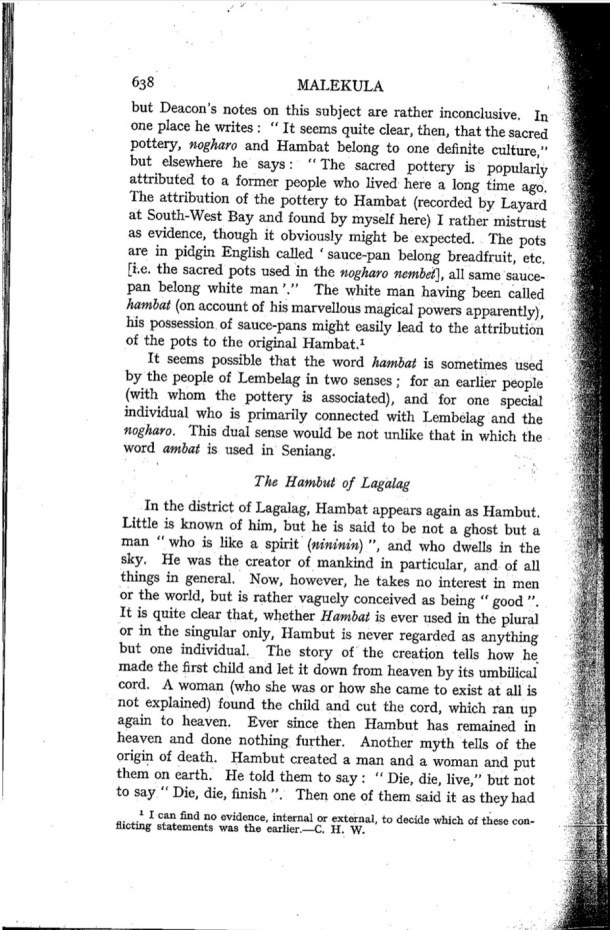|
|  [Note: this transcription was produced by an automatic OCR engine]
_i.._
A
638 MALEKULA ‘
but Deacon's notes on this subject are rather inconclusive. In
one place he writes 1 “ It seems quite clear, then, that the sacred
pottery, naghzua and Hambat belong to one deï¬Ånite culture,"
but elsewhere he says : “ The sacred pottery is popularly
attributed to a former people who Lived here a long time ago.
The attribution of the pottery to Hambat (recorded by Layard
at South-West Bay and found by myself here) I rather mistrust
as evidence, though it obviously might be expected. The pots
are in pidgin English called ' sauce-pan belong breadiruit, etc.
[i.e. the sacred pots used in the nogharo mmbet], all same sauce-
pan belong white man '." The white man having been called
hamba! (on account of his marvellous magical powers apparently),
his possession of sauce-pans might easily lead to the attribution
of the pots to the original Hambatl
It seems possible that the word Inzmbat is sometimes used
by the people of Lembelag in two senses ; for an earlier people
(with whom the pottery is associated), and for one Special
individual who is primarily connected with Lembelag and the
nnghnrv. This dual sense would be not unlike that in which the
word ambat is used in Seniang. ‘
The Hambut of Lagalag
In the district of Lagalag, Hambat appears again as Hambut.
Little is known of him, but he is said to be not a ghost but a.
man “ who is like a spirit (m'm'm'n) â€ù, and who dwells in the
sky. He was the creator of mankind in particular, and of all
things in general. Now, however, he takes no interest in men
or the world, but is rather vaguely conceived as being " good â€ù.
It is quite clear that, whether Hambat is ever used in the plural
or in the singular only, I-Iarnbut is never regarded as anything
but one individual. The story of the creation tells how he_
made the ï¬Årst child and let it down from heaven by its umbilical
cord. A woman (who she was or how she came to exist at all is
not explained) found the child and cut the cord, which ran up
again to heaven. Ever since then Hambut has remained in
heaven and done nothing further. Another myth tells of the
origin of death. Hambut created a man and a woman and put
them on earth. He told them to say : “ Die, die, live," but not
to say " Die, die, ï¬Ånish ". Then one of them said it as they had
* I can ï¬Ånd no evidence, internal or external, to decide which of these con-
flicting statements was the ta:'lie'r.—C, H. W.
t.
r
i.
H‘
,_ z
‘l= 1
. =
,. ‘
A ,
. _ 5 ,
. Wt‘
. 1:; V
:_'i?t ..
T 2%‘
.
|